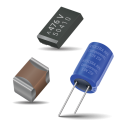Surface Mount Capacitors for DC-DC Converter Applications Written By: Naotaka Hata Abstract: Tantalum, polymer, ceramic, film, and aluminum capacitors each offer a different set of operating and performance characteristics. Choosing the proper capacitor when designing DC-DC converters requires a careful understanding of these differences. High voltage front-end connections to the power source typically rely on aluminum capacitors, while intermediate step-down voltages often look towards the tantalum and ceramic families to take advantage of volumetric efficiency. The final load decoupling and bypass capacitors are generally found in the ceramic and film families. Surface mount (SMD) capacitors can be constructed using several different technologies to achieve a range of voltage tolerance, bulk capacitance, and parasitic device characteristics. As shown in Figure 1,
Aluminum Capacitors
Aluminum Capacitors for LED Lighting Written By: Raul Wang Abstract: While relatively expensive, LED lighting is more reliable, more configurable, and uses significantly less electrical power for the same luminous output when compared to its incandescent, fluorescent, and halogen counterparts.
Aluminum Electrolytic Capacitor Use in Three-Phase BLDC Motor Controllers Written By: Ron Demcko | Slavomir Pala Abstract: The uses of industrial control systems and robotics are expanding rapidly due to their positive impact on costs and quality. This paper will discuss Aluminum Electrolytic capacitor roles as an output filter capacitor to improve power quality in Brushless DC Motor (BLDC) motor controller & drives. Aluminum Electrolytic capacitors can be used to provide exacting drive voltage to motors. This in turn improves system reliability and performance. The case studied will be a 3-phase, 24V / 30 watt BLDC motor with a rated speed of 4000rpm and rated torque of 0.072 N-m.
Replacing Aluminum Electrolytic Capacitors with Tantalum or Ceramic Capacitors Written By: Teddy Won Abstract: Like all capacitors, electrolytics (e-caps) are based on the principle of storing energy in an electric field using a voltage applied across a dielectric. This paper discusses the basic structure and characteristics of electrolytics and shows alternates for circuit use.
Tantalum Polymer vs Aluminum Polymer Performance as an Output Filter Capacitor for Miniature Switching Power Supplies Written By: Ron Demcko | Ashley Stanziola | Daniel West Abstract: Engineers have questioned the impact performance of converting Aluminum Polymer capacitors to Tantalum Polymer capacitors in applications where MLCCs are present on the output filter ‘bank’ of a small switching power supply. The reasons for designers to convert to Tantalum Polymer capacitors in the design ranged from long term reliability and stability to availability/delivery and company specific design guidelines. This investigation is intended to compare the interchangeability of Tantalum Polymer Capacitors in a design with the original Aluminum Polymer capacitors. The data collected was the measured output voltage ripple on a highly utilized






